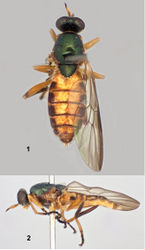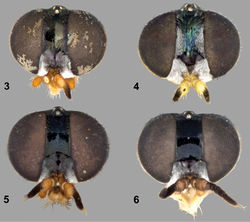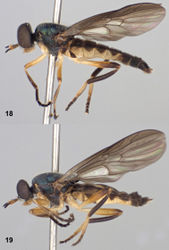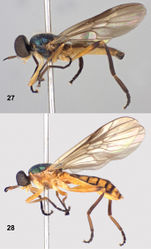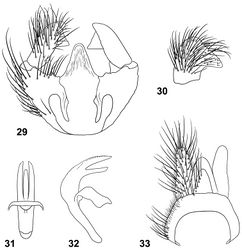Paraberismyia
| Notice: | This page is derived from the original publication listed below, whose author(s) should always be credited. Further contributors may edit and improve the content of this page and, consequently, need to be credited as well (see page history). Any assessment of factual correctness requires a careful review of the original article as well as of subsequent contributions.
If you are uncertain whether your planned contribution is correct or not, we suggest that you use the associated discussion page instead of editing the page directly. This page should be cited as follows (rationale):
Citation formats to copy and paste
BibTeX: @article{Woodley2013ZooKeys353, RIS/ Endnote: TY - JOUR Wikipedia/ Citizendium: <ref name="Woodley2013ZooKeys353">{{Citation See also the citation download page at the journal. |
Ordo: Diptera
Familia: Stratiomyidae
Name
Paraberismyia Woodley, 1995 – Wikispecies link – Pensoft Profile
- Paraberismyia Woodley 1995[1]: 134. Type species, Paraberismyia tzontehuitza Woodley, by original designation.
Diagnosis
Woodley (1995)[1] fully diagnosed and described Paraberismyia within the context of the world fauna of Beridinae. It may be separated from all other world genera of beridines except Allognosta Osten Sacken and Berismyia Giglio-Tos by having distinct hair-like setae around the apical margin of the first antennal flagellomere. Paraberismyia may be separated from Allognosta because it possesses denticles on the posterior margin of the scutellum, which Allognosta lacks. Allognosta is also not known to occur in Mexico or Central America. Species of Berismyia overlap in distribution with Paraberismyia. Berismyia are drab colored flies with a brownish to black mesonotum with at most faint metallic reflections and a dark brownish to black, unicolorous abdomen, whereas Paraberismyia are more brightly colored with a distinctly metallic mesonotum and an abdomen that is bicolored. Also, all known species of Berismyia (including several that are undescribed) have the genital capsule with a very long, narrow, posteromedial process on the synsternite that is sharply acute apically (Woodley 1995[1]: 191, fig. 126), while in Paraberismyia this process is shorter, broader, and has a rounded apex (Figs 11, 20, 29).
Remarks
The species of Paraberismyia are very similar in general structure, differing mainly in characters of coloration and the male terminalia. The coloration differences are very consistent and therefore can be used to accurately identify the species.
Key to species of Paraberismyia
Taxon Treatment
- Woodley, N; 2013: A revision of the Neotropical genus Paraberismyia Woodley (Diptera, Stratiomyidae, Beridinae) with three new species ZooKeys, 353: 25-45. doi
Other References
- ↑ 1.0 1.1 1.2 Woodley N (1995) The genera of Beridinae (Diptera: Stratiomyidae). Memoirs of the Entomological Society of Washington 16: 1-231.
Images
|
